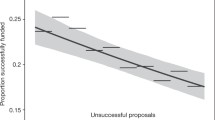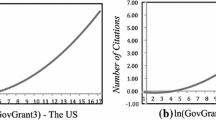Abstract
There is increasing interest in assessing how sponsored research funding influences the development and trajectory of science and technology. Traditionally, linkages between research funding and subsequent results are hard to track, often requiring access to separate funding or performance reports released by researchers or sponsors. Tracing research sponsorship and output linkages is even more challenging when researchers receive multiple funding awards and collaborate with a variety of differentially-sponsored research colleagues. This article presents a novel bibliometric approach to undertaking funding acknowledgement analysis which links research outputs with their funding sources. Using this approach in the context of nanotechnology research, the article probes the funding patterns of leading countries and agencies including patterns of cross-border research sponsorship. We identify more than 91,500 nanotechnology articles published worldwide during a 12-month period in 2008–2009. About 67% of these publications include funding acknowledgements information. We compare articles reporting funding with those that do not (for reasons that may include reliance on internal core-funding rather than external awards as well as omissions in reporting). While we find some country and field differences, we judge that the level of reporting of funding sources is sufficiently high to provide a basis for analysis. The funding acknowledgement data is used to compare nanotechnology funding policies and programs in selected countries and to examine their impacts on scientific output. We also examine the internationalization of research funding through the interplay of various funding sources at national and organizational levels. We find that while most nanotechnology funding is nationally-oriented, internationalization and knowledge exchange does occur as researchers collaborate across borders. Our method offers a new approach not only in identifying the funding sources of publications but also in feasibly undertaking large-scale analyses across scientific fields, institutions and countries.





Similar content being viewed by others
Notes
Note that author countries and funding countries of publications do not necessarily correspond. It is possible that authors are affiliated with institutions in two countries but receive funding from only one country, or both countries, or even a third country. Additionally, the amount of funding is typically not reported in the acknowledgment text. For a paper reporting sponsorship from multiple countries or sponsors, we do not know the relative contributions provided by each country’s funding source or from individual sponsors. Hence, in our analysis, papers with multiple funding countries or sponsors are assigned equally to all indicated countries and sponsors, using whole counting. Thus, a paper with funding from country X and country Y is allocated 1 to country X and 1 to country Y. Similarly, a paper with funding from sponsor A and sponsor B is credited 1 to sponsor A and 1 to sponsor B.
China in this paper refers to mainland China. Hong Kong, Macau and Taiwan are treated separately as research in these regions is not funded through the same system as the one in mainland China.
References
Adams, J. D., & Griliches, Z. (1998). Research productivity in a system of universities. Annales d’Economie et de Statisque, 49/50, 127–162.
Baird, D., & Shew, A. (2004). Probing the history of scanning tunneling microscopy. In D. Baird, A. Nordmann, & J. Schummer (Eds.), Discovering the nanoscale. Amsterdam: IOS Press.
Baker, S., & Aston, A. (2005). The business of nanotech. Business Week. Feb 14, 64–71.
Boyack, K. W., & Borner, K. (2003). Indicator-assisted evaluation and funding of research: visualizing the influence of grants on the number of citation counts of research papers. Journal of the American Society for Information Science and Technology, 54(5), 447–461.
Braun, D. (1998). The role of funding agencies in the cognitive development of science. Research Policy, 27(8), 807–821.
Broadhead, R. S., & Rist, R. C. (1976). Gatekeepers and the social control of social research. Social Problems, 23(3), 325–336.
Butler, L. (2001). Revisiting bibliometric issues using new empirical data. Research Evaluation, 10(1), 59–65.
Campbell, D., Picard-Aitken, M., Cote, G., Caruso, J., Valentim, R., Edmonds, S., et al. (2010). Bibliometrics as a performance measurement tool for research evaluation: The case of research funded by the National Cancer Institute of Canada. American Journal of Evaluation, 31(1), 66–83.
Cronin, B., & Shaw, D. (1999). Citation, funding acknowledgement and author nationality relationships in four information science journals. Journal of Documentation, 55(4), 402–408.
Drexler, E. (1986). Engines of creation: The coming era of nanotechnology. New York: Anchor Books.
European Commission. (2004). Towards a European strategy for nanotechnology. Brussels: DG Research.
European Commission (2009). Nanosciences and nanotechnologies: An action plan for Europe 2005–2009, Second Implementation Report 2007–2009. Brussels: European Commission. Retrieved April 16, 2010 from http://ec.europa.eu/nanotechnology/index_en.html.
Gaughan, M., & Bozeman, B. (2002). Using curriculum vitae to compare some impacts of NSF research grants with research center funding. Research Evaluation, 11(1), 17–26.
Griliches, Z. (1985). Productivity, R&D, and basic research at the firm level in the 1970s. NBER Working Paper No. W1547. Boston, MA: National Bureau of Economic Research.
Harter, S. P., & Hooten, P. A. (1992). Information science and scientists: JASIS, 1972–1990. Journal of the American Society for Information Science, 43(9), 583–593.
Heinze, T., Shapira, P., Senker, J., & Kuhlmann, S. (2007). Identifying creative research accomplishments: Methodology and results for nanotechnology and human genetics. Scientometrics, 70(1), 125–152.
Hicks, D., Albert, M., Breitzman, T., & Cheney, P. (2002). Bibliometric analysis of core papers fundamental to tissue engineering. Haddon Heights: CHI Research, Inc.
Huang, Z., Chen, H., Li, X., & Roco, M. C. (2006). Connecting NSF funding to patent innovation in nanotechnology (2001–2004). Journal of Nanoparticle Research, 8, 859–879.
Joint Economic Committee. (2007). Nanotechnology: The future is coming sooner than you think. Washington: US Congress.
Kearnes, M., & Wienroth, M. (2009). ‘Arm’s length’? Narratives of impact and autonomy in UK Research Councils. Working Paper. ESRC Project on Strategic Science: Research Intermediaries and the Governance of Innovation. UK: Department of Geography, Durham University.
King, J. (1987). A review of bibliometrics and other science indicators and their role in research evaluation. Journal of Information Science, 13, 261–276.
Lewison, G., & Carding, P. (2003). Evaluating UK research in speech and language therapy. International Journal of Language & Communication Disorders, 38, 48–65.
Lichtenberg, F. R. (1985). Assessing the impact of federal industrial r&d expenditures on private r&d activity. Papers commissioned for a workshop on the federal role in research and development. The National Academies Press, pp. 115–150.
Lux Research. (2004). The nanotech report: investment overview and market research for nanotechnology. New York: Lux Research.
Lux Research. (2006). The nanotech report (4th ed.): Investment overview and market research for nanotechnology. New York: Lux Research.
Lux Research. (2007). Top nations in nanotech see their lead erode. New York: Lux Research.
Mansfield, E. (1980). Basic research and productivity increase in manufacturing. American Economic Review, 70(5), 863–873.
Mansfield, E. (1981). How economists see R&D. Harvard Business Review, 59(6), 98–106.
Martin, B., Salter, A., Hicks, D., Pavitt, K., Senker, J. Sharp, M., & von Tunzelmann, N. (1996). The relationship between publicly funded basic research and economic performance: A SPRU review. Report prepared for HM treasury. University of Sussex, Brighton.
McAllister, P.R., Narin, F., & Corrigan, J.G. (1983). Programmatic evaluation and comparison based on standardized citation scores. IEEE Transactions on Engineering Management, EM-30, 4.
OMB. (1993). Government Performance Results Act of 1993. Washington, DC: Executive Office of the President of the United States, Office of Management and Budget.
OTA. (1986). Research funding as an investment: Can we measure the returns? A technical memorandum. OTA-TMSET-36. Washington: US Congress, Office of Technology Assessment.
OTA. (1991). Federally funded research: Decisions for a decade. OTA-SET-490. Washington: US Congress, Office of Technology Assessment.
Paasi, M. (1998). Efficiency of innovation systems in the transition countries. Economic Systems, 22(3), 217–234.
Pavitt, K. (1991). What makes basic research economically useful? Research Policy, 20, 109–119.
Payne, A. A., & Siow, A. (2003). Does federal research funding increase university research output? Advances in Economic Analysis & Policy, 3(1), Article 1.
PCAST. (2005). The national nanotechnology initiative at five years: Assessment and recommendations of the national nanotechnology advisory panel. Washington: The President’s Council of Advisors on Science and Technology (PCAST).
Peterson, C. (1991). Nanotechnology race: MITI adopts ‘Bottom-Up’ strategy. Foresight Update 12, August 1. http://www.foresight.org/Updates/Update12/index.html.
Porter, A. L., & Youtie, J. (2009). How interdisciplinary is nanotechnology? Journal of Nanoparticle Research, 11(5), 1023–1041.
Porter, A. L., Youtie, J., Shapira, P., & Schoeneck, D. J. (2008). Refining search terms for nanotechnology. Journal of Nanoparticle Research, 10(5), 715–728.
Rigby, J. (2011). Systematic grant and funding body acknowledgement data for publications: An examination of new dimensions and new controversies for bibliometrics. Manchester Business School, Working Paper, No. 611. Manchester, UK: University of Manchester.
Roco, M. C. (2007). National nanotechnology initiative—past, present, future. In W. A. Goddard, D. Brenner, S. E. Lyshevski, & G. J. Iafrate (Eds.), Handbook on Nanoscience, Engineering and Technology (2nd ed.). Boca Raton: Taylor and Francis.
Sandstrom, U. (2009). Research quality and diversity of funding: A model for relating research money to output of research. Scientometrics, 79(2), 341–349.
Sarewitz, D. (1997). Social change and science policy. Issues in Science and Technology, XIII(4), 29–32.
Sargent, J. F. (2008). Nanotechnology and U.S: Competitiveness. Issues and Options. RL34493. Washington: Congressional Research Service.
Science and Technology Committee. (2004). Science and technology—fifth report. London: House of Commons.
Shapira, P., & Wang, J. (2007). R&D policy in the United States: The promotion of nanotechnology R&D. Monitoring and analysis of policies and public financing instruments conducive to higher levels of R&D investments—The “Policy Mix” Project. European Commission, DG Research (DG-RTD-2005-M-01-02). ftp://ftp.cordis.europa.eu/pub/nanotechnology/docs/pmcasestudy_us_nanotech11.pdf. Accessed 4 Nov 2010.
Shapira, P., & Wang, J. (2010). Follow the money: What was the impact of the nanotechnology funding boom of the past ten years? Nature, 468, 627–628.
Solow, R. M. (1957). Technical change and the aggregate production function. The Review of Economics and Statistics, 39(3), 312–320.
Takemura, M. (2005). Strategic promotion of nanotechnology R&D in Japan. Tsukuba-City: National Institute for Materials Science.
Terleckyj, N. E. (1974). Effects of R&D on the productivity growth of industries: An exploratory study. Washington: National Planning Association.
Terleckyj, N. E. (1985). Measuring economic effects of federal R&D expenditures: Recent history with special emphasis on federal R&D performed in industry. Papers commissioned for a workshop on the federal role in research and development. Washington: The National Academies Press, pp. 151–172.
Thomson Reuters. (2010). Funding acknowledgements. http://wokinfo.com/products_tools/multidisciplinary/webofscience/fundingsearch. Accessed 2 May 2010.
Trochim, W. M., Marcus, S. E., Masse, L. C., Mose, R. P., & Weld, P. C. (2008). The evaluation of large research initiatives: a participatory integrative mixed-methods approach. American Journal of Evaluation, 29, 8–28.
Uldrich, J., & Newberry, D. (2003). The next big thing is really small: How nanotechnology will change the future of your business. New York: Crown Business.
Woolgar, L. (2010). ERAWATCH research inventory report for JAPAN. European Commission: ERAWATCH. http://cordis.europa.eu/erawatch/index.cfm?fuseaction=ri.content&topicID=4&countryCode=JP. Accessed 15 Mar 2010.
Youtie, J., Shapira, P., & Porter, A. (2008). Nanotechnology publications and citations by leading countries and blocs. Journal of Nanoparticle Research, 10, 981–986.
Acknowledgements
This research was supported in part by the Center for Nanotechnology in Society at Arizona State University (CNS-ASU) under National Science Foundation Award 0531194. The authors gratefully acknowledge comments and suggestions received from Ismael Rafols, Luciano Kay and Abdullah Gok. The findings in this article are those of the authors and do not necessarily reflect the views of the National Science Foundation and the others.
Author information
Authors and Affiliations
Corresponding author
Rights and permissions
About this article
Cite this article
Wang, J., Shapira, P. Funding acknowledgement analysis: an enhanced tool to investigate research sponsorship impacts: the case of nanotechnology. Scientometrics 87, 563–586 (2011). https://doi.org/10.1007/s11192-011-0362-5
Received:
Published:
Issue Date:
DOI: https://doi.org/10.1007/s11192-011-0362-5
Keywords
- Funding acknowledgement analysis
- Research funding
- Research sponsorship
- Nanotechnology
- Research outputs
- Publications
- Bibliometrics




